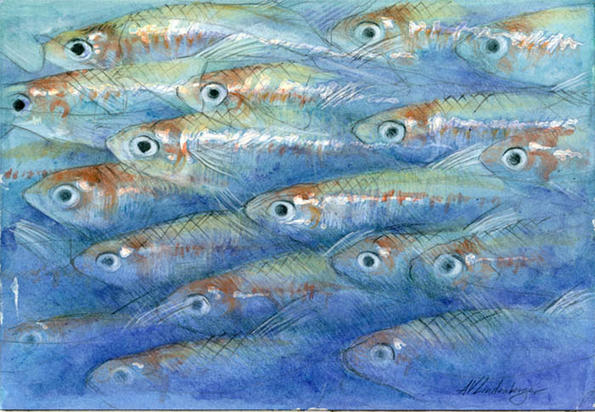Artists Respond to Dunkard Fish Kill
Charleston Gazette
9 December 2011
By Lori Kersey

The Ghost Shiner, shown here in a
portrait by Amy Lindenberger, has little or no pigment. -
Courtesy photo
CHARLESTON, W.Va. -- Two years ago when a friend insisted that
Ann Payne go to Dunkard Creek and survey the damage there, she was
shocked by what she saw.
The stream that runs along the border of Pennsylvania and West
Virginia was experiencing one of the worst fish kills in either
state's history. Once a habitat for all sorts of fish, mussels,
amphibians and other creatures, 18,000 to 22,000 animals in a
43-mile stream were dead or dying.
"It was the worst thing you can imagine, just death everywhere,"
Payne recalls. "Every type of fish ... Some had tried to get out
of the water. It was horrible. I was just traumatized."
Scientists attributed the fish and animal kill to a toxic algae
bloom.
Payne lived 12 miles from the creek and said she previously didn't
feel a connection with it. But after seeing the destruction, she
couldn't help but be moved.
"You can't see something like that and not do something," she
said.
So Payne, an art instructor and member of the Guild of Natural
Science Illustrators, came up with an idea to illustrate each of
the species that perished in the kill. It was a way for her to
respond to what she had seen that day, she said.
What ultimately resulted was an art exhibit in which 90 artists
illustrated each of the 90 species that lived and were killed in
Dunkard Creek.
The work of Payne and her fellow artists, "Reflections: Homage to
Dunkard Creek," will be on display at the Frankenberger Gallery at
the University of Charleston from Dec. 15 through Jan. 25.
Payne initially planned to illustrate the creatures by herself.
"That was 2009, and by 2010, I had done seven portraits," she
recalled. "I thought, 'the math isn't working.' So I decided to
ask for help."
She enlisted the help of 89 other artists, each with a tie to the
Monongahela Watershed, where Dunkard Creek flows.
Knowing just a handful of artists from the Pittsburgh area where
she teaches, Payne placed cold calls to many of the artists that
worked on the project. She said she had an "enormously good
response" from the artists she asked. One artist, she recalls,
told her he felt like he had been waiting for her to ask him.
"Amazingly, I think I only had one artist that didn't produce [by]
the deadline," she said.
The answer to what caused the algae bloom and fish kill is still
unfolding. Mining company Consol Energy ultimately paid $5.5
million in civil penalties for pollution violations relating to
the fish kill. More recently, one of the lead scientists
investigating the incident has indicated that the discharge from a
fracking well may have caused the algae.
Brent Bailey, director of the Mountain Institute Appalachia
Program, which sponsors the exhibit, said the show is not about
placing blame.
"I don't see the exhibit as having one message, but a series of
questions," Bailey said. "It doesn't bash anyone."
Bailey said what happened at Dunkard Creek raises questions about
who owns the water and what responsibilities people have to
conserve it.
Bailey provided the catalogue for the art exhibit. The booklet
includes each artist's rendering as a description of the animals.
"[I wanted to] add some educational piece to the show," Bailey
said, adding that the show stands alone on its merit. The idea is
that people can take it home and learn more about each of the
creatures that died in the fish kill, he said.
Some of the portraits are whimsical, others are beautiful or
political, Bailey said.
"It was a huge range," he said. "When you have 90 artists doing 90
portraits and most of the artists didn't know the species before
[the project], you're going to get a variety."
The show debuted in Morgantown Sept. 9. Local artists told Bailey
and Payne that it was the most-attended art opening in Morgantown
they had ever seen.
From elected officials to voters and fishermen, Bailey said a
variety of people came to the opening. The show is now booked in
places from Charleston to Pittsburgh for the next two years,
Bailey said.
"There's something in the show for everyone," he said. "It's a
show that has real broad appeal ... I hope that people will take
advantage of [seeing] it."
A reception and gallery talk is planned from 6 p.m. to 9 p.m. Dec.
15 at the Frankenberger Art Gallery at the University of
Charleston. For more information, contact curator Ray Yeager at
(304) 357-4387.
Reach Lori Kersey at lori.ker...@wvgazette.com or 304-348-1240.
